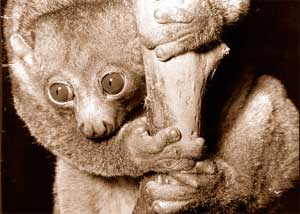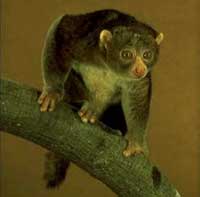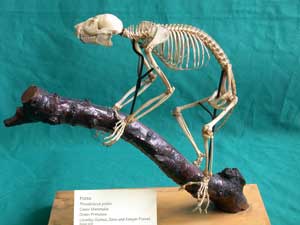 The potto (Perodicticus potto) is rarely seen, as during the day they hide and sleep among dense branches, curling up with their heads tucked between their legs.
The potto (Perodicticus potto) is rarely seen, as during the day they hide and sleep among dense branches, curling up with their heads tucked between their legs.
The potto has a body length of about 38 cm, a tail length of approximately 6 cm, and weighs around 1.5 kg. They only wake up at night. In the dark depths of the forest, the potto moves slowly and cautiously, stepping one foot at a time, resembling a tightrope walker.
Interestingly, these animals never leave the trees; they never set foot on the ground. They typically reside in trees at heights ranging from 5 to 30 meters. Normally, they grip the branches tightly, making it difficult to dislodge them.
The hands and feet of the potto are capable of grasping like human hands, allowing them to adapt well to clinging to branches. Due to specialized blood storage areas in their hands and feet, potto can maintain a strong grip on branches for extended periods without tiring. Their second toe has a claw, which is used for grooming. All other fingers are flat like human fingers.
There are four bony spines on the back of the potto’s neck, which are extensions from the vertebrae, covered with hairless lumps.
 Diet primarily consists of fruits and various plant materials. However, they also consume insects and snails; in some areas, they have been known to eat caterpillars, stinging hairs, foul-smelling beetles, and venomous centipedes. Pottos have developed a clever way of feeding: they often rub stinging caterpillars to release many stinging hairs before putting them in their mouths. They also eat poisonous ants. Additionally, pottos can hunt and consume young birds or bats.
Diet primarily consists of fruits and various plant materials. However, they also consume insects and snails; in some areas, they have been known to eat caterpillars, stinging hairs, foul-smelling beetles, and venomous centipedes. Pottos have developed a clever way of feeding: they often rub stinging caterpillars to release many stinging hairs before putting them in their mouths. They also eat poisonous ants. Additionally, pottos can hunt and consume young birds or bats.
In the dark, pottos manage to find food—not because their eyesight is keen but because they rely on smell. Although they move slowly, when they approach their prey, they can quickly snatch it with their hands and mouths.
Pottos are quite aggressive, defending themselves with strong bites; their primary predator is large owls.
Pottos typically live alone, except for a short period during the breeding season. Scientists know very little about the reproductive habits of these unique creatures. However, some information has been gathered about their reproduction: the male’s call to attract females sounds like a child’s cry; during mating, males and females stay together all night, and during the day, they are awake together, yet they never sleep side by side.
 |
|
Potto Skeleton |
Each year, females give birth to one offspring, with a gestation period of 6 to 6.5 months. The young cling to their mother’s belly until they are about three weeks old. As the young grow older, while the mother potto forages at night, she leaves the young hanging safely on a branch, returning to the nest after foraging to sleep together all day. Occasionally, the weaning young will climb onto the mother’s back to accompany her while foraging.
Young pottos are weaned at 4-5 months old (from January to March), which is when there is an abundance of fruit in the forest. Young males leave their mother’s territory at around 6 months old. Young females become independent at about 8 months old but remain in their mother’s territory for a while longer.
In the wild, pottos live at a density of about 8-10 individuals per km2. Each adult occupies a sufficiently large territory (approximately 6-9 hectares) to provide for themselves and their offspring. In contrast, adult males typically control territories ranging from 9 to 40 hectares, which may overlap with one or more females. However, an adult male’s territory never overlaps with that of another male. Pottos communicate with each other through vocalizations and by leaving urine markings on branches.
This slow-moving animal is also beneficial, aiding in seed dispersal of the fruits they consume. Pottos are often hunted by humans for their meat.
Pottos live for approximately 22 years. They inhabit the rainforests along the coasts of West and Central Africa.



















































